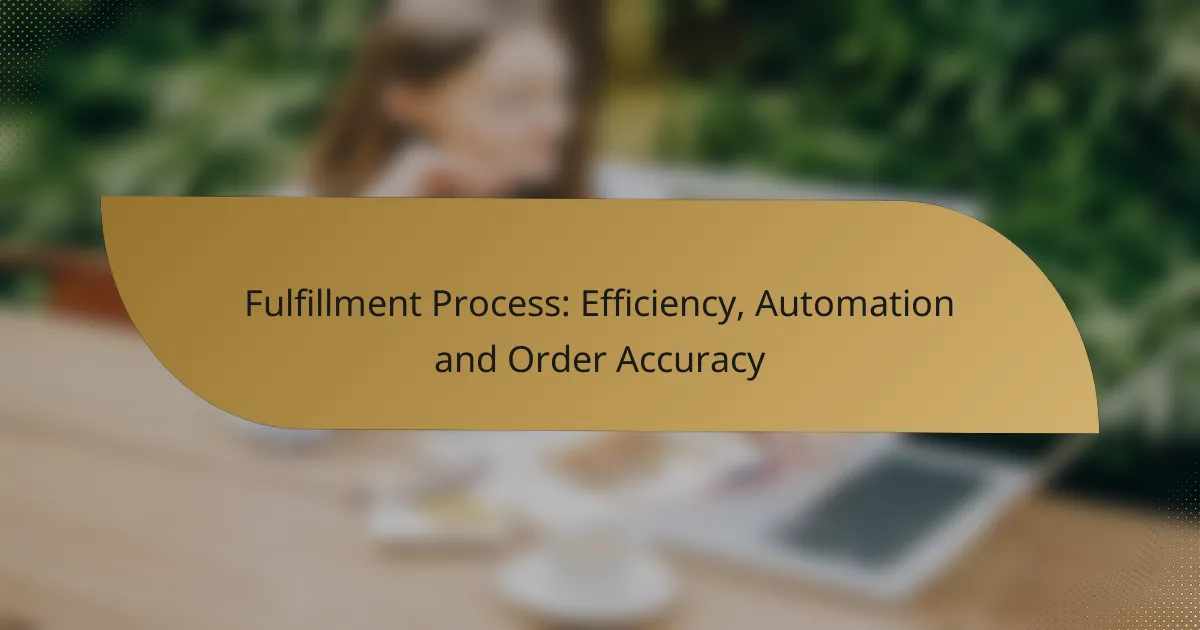The fulfillment process is crucial for e-commerce businesses aiming to enhance efficiency and order accuracy. By leveraging technology-driven solutions and automation, companies can streamline operations, reduce errors, and improve overall performance. Key strategies include optimizing inventory management, utilizing real-time data analytics, and enhancing supplier collaboration to ensure timely and accurate order fulfillment.

How can e-commerce businesses improve fulfillment efficiency?
E-commerce businesses can enhance fulfillment efficiency by adopting technology-driven solutions and optimizing their processes. Key strategies include implementing warehouse management systems, optimizing inventory management, utilizing real-time data analytics, streamlining shipping processes, and enhancing supplier collaboration.
Implementing warehouse management systems
Warehouse management systems (WMS) automate various warehouse operations, improving accuracy and speed. By using a WMS, businesses can track inventory levels, manage order fulfillment, and optimize storage space effectively.
Consider integrating a WMS that suits your business size and needs. For example, cloud-based solutions can offer scalability and flexibility, while on-premise systems may provide more control over data security.
Optimizing inventory management
Effective inventory management ensures that stock levels align with demand, reducing excess inventory and stockouts. Techniques such as just-in-time (JIT) inventory can help maintain optimal stock levels while minimizing holding costs.
Utilize inventory management software to forecast demand accurately and automate reordering processes. Regularly review your inventory turnover rates to identify slow-moving items and adjust purchasing strategies accordingly.
Utilizing real-time data analytics
Real-time data analytics provides insights into customer behavior, order trends, and supply chain performance. By analyzing this data, businesses can make informed decisions that enhance fulfillment efficiency.
Implement tools that offer dashboards and reporting features to monitor key performance indicators (KPIs) such as order accuracy and delivery times. This information can guide adjustments in processes and resource allocation.
Streamlining shipping processes
Streamlining shipping processes can significantly reduce delivery times and costs. Evaluate shipping options and negotiate rates with carriers to find the most efficient solutions for your business.
Consider implementing automated shipping software that integrates with your e-commerce platform. This can simplify label printing, tracking, and communication with customers regarding their orders.
Enhancing supplier collaboration
Strong collaboration with suppliers can lead to improved fulfillment efficiency by ensuring timely deliveries and better communication. Establish clear expectations and maintain regular contact to address any issues proactively.
Utilize collaborative tools and platforms that allow for real-time sharing of information regarding inventory levels and order statuses. This transparency can help both parties respond quickly to changes in demand or supply chain disruptions.

What role does automation play in the fulfillment process?
Automation significantly enhances the fulfillment process by improving efficiency, reducing errors, and speeding up order processing. By integrating automated systems, businesses can streamline operations, minimize labor costs, and increase order accuracy.
Automated picking and packing systems
Automated picking and packing systems utilize technology to select and package items for shipment without human intervention. These systems often employ conveyor belts, robotic arms, and sensors to efficiently handle products, which can reduce picking times to mere seconds per item.
For optimal performance, businesses should assess their inventory size and order volume before implementing these systems. A common pitfall is underestimating the complexity of integrating automation into existing workflows, which can lead to disruptions if not managed properly.
Robotic process automation for order management
Robotic process automation (RPA) in order management automates repetitive tasks such as data entry, order tracking, and inventory updates. This technology allows for faster processing times and minimizes human error, ensuring that orders are fulfilled accurately and promptly.
Companies should consider RPA for tasks that are rule-based and high in volume. However, it is crucial to maintain oversight and regularly update the RPA systems to adapt to changing business needs and regulations.
Integration of AI in demand forecasting
Integrating artificial intelligence (AI) into demand forecasting helps businesses predict customer needs more accurately. AI analyzes historical sales data, market trends, and consumer behavior to provide insights that enhance inventory management and reduce stockouts or overstock situations.
To effectively implement AI in demand forecasting, businesses should ensure they have access to quality data and invest in training staff to interpret AI-generated insights. Avoid relying solely on AI; combining human expertise with AI analysis often yields the best results in forecasting accuracy.

How can order accuracy be ensured in fulfillment?
Order accuracy in fulfillment can be ensured through systematic processes that minimize errors and enhance tracking. Implementing technology, conducting audits, and performing quality checks are key strategies to achieve high levels of accuracy.
Implementing barcode scanning technology
Barcode scanning technology significantly reduces human error by automating the data entry process. By scanning items at various stages—receiving, picking, packing, and shipping—fulfillment centers can ensure that the correct products are being handled. This technology can increase efficiency and accuracy, often reducing order processing times to mere seconds.
When implementing barcode systems, consider integrating them with inventory management software. This allows for real-time tracking and updates, helping to maintain accurate stock levels and preventing discrepancies.
Conducting regular inventory audits
Regular inventory audits are essential for maintaining order accuracy. These audits help identify discrepancies between physical stock and recorded inventory, allowing businesses to address issues promptly. It’s advisable to conduct audits at least quarterly, though monthly checks can be beneficial for high-volume operations.
During an audit, utilize cycle counting, where a portion of inventory is counted in rotation, to streamline the process. This method minimizes disruption and helps maintain continuous operations while ensuring accuracy.
Utilizing quality control checks
Quality control checks serve as a final verification step before orders are shipped. Implementing a system where items are double-checked against order lists can significantly reduce errors. For example, having a second employee verify the picked items against the packing list can catch mistakes before they reach the customer.
Establish clear criteria for quality control, such as checking for damage, verifying quantities, and ensuring correct packaging. Regular training for staff on these procedures can enhance compliance and improve overall order accuracy.

What are the key performance indicators for fulfillment success?
Key performance indicators (KPIs) for fulfillment success include metrics that measure the efficiency and accuracy of the order fulfillment process. These indicators help businesses assess their operational performance and identify areas for improvement.
Order fulfillment cycle time
Order fulfillment cycle time measures the total time taken from when a customer places an order until it is delivered. This metric is crucial as it directly impacts customer satisfaction and retention. Businesses typically aim for a cycle time of a few days to a week, depending on the complexity of the order and shipping methods.
To optimize cycle time, companies should streamline their picking and packing processes, utilize efficient shipping methods, and maintain clear communication with customers. Regularly reviewing and adjusting workflows can help reduce delays and improve overall efficiency.
Perfect order rate
The perfect order rate indicates the percentage of orders delivered without any issues, such as delays, inaccuracies, or damages. A high perfect order rate, often targeted at 95% or above, reflects strong fulfillment accuracy and reliability. This metric is essential for building customer trust and loyalty.
To enhance the perfect order rate, businesses should implement quality control checks throughout the fulfillment process, invest in employee training, and utilize technology for inventory management. Monitoring this KPI regularly can help identify recurring issues and areas needing attention.
Inventory turnover ratio
The inventory turnover ratio measures how often inventory is sold and replaced over a specific period, typically calculated annually. A higher ratio indicates efficient inventory management, while a lower ratio may signal overstocking or slow-moving products. Retailers often aim for a turnover ratio of 5 to 10, depending on the industry.
To improve the inventory turnover ratio, businesses should analyze sales trends, optimize stock levels, and implement just-in-time inventory practices. Regularly reviewing inventory performance can help ensure that products are moving efficiently and reduce holding costs.

What technologies enhance fulfillment in major markets?
Technologies such as automation software, robotics, and drones significantly enhance fulfillment processes in major markets. These innovations improve efficiency, reduce errors, and speed up delivery times, making them essential for competitive businesses.
Use of drones for delivery
Drones are increasingly being utilized for delivery, especially in urban areas where speed is crucial. They can transport packages directly to customers’ doorsteps, bypassing traffic and reducing delivery times to mere minutes in some cases.
When considering drone delivery, businesses must evaluate factors such as regulatory compliance, package weight limits, and operational costs. In the U.S., for example, the FAA has established guidelines that dictate where and how drones can operate, which can affect logistics planning.
Companies like Amazon and UPS are already testing drone delivery systems, aiming to enhance customer satisfaction and streamline operations. However, businesses should also consider the initial investment and ongoing maintenance costs associated with drone technology before implementation.
